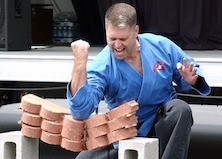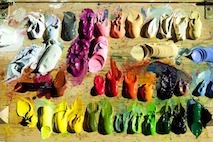Improvise For Real: 5 Tips For Success
 Would you like to learn how to improvise for real? You’ve come to the right place.
Would you like to learn how to improvise for real? You’ve come to the right place.
In this lesson, you will learn all about unlocking your potential as an improviser on the piano.
This lesson reveals all the essentials you need to get started with improvisation.
Let’s start breaking down 5 tips to get you improvising solos instantly.
1. How To Listen Actively
 To learn how to improvise for real, you need to first immerse yourself and listen amazing improvisers.
To learn how to improvise for real, you need to first immerse yourself and listen amazing improvisers.
Make it a point to listen to great jazz legends. Focus on just a few for a period of time.
Start with your favorite jazz artists or any tune from the best jazz albums. As you listen to them, identify aspects of their music that appeal to you most.
Is it their sense of groove? The chord voicings they use? The lines they play?
Try your best to figure out why your favorite jazz master plays in a certain way.
Let me give you an example:
One of my favorite jazz improvisers is Chet Baker. and something about his solo on Autumn Leaves was very appealing to me.
And so, I spent a lot of time listening to his version of Autumn Leaves. I did this to the extent that I can remember it enough to emulate it.
This deep approach to listening comes out in my playing. Remember, you first learned how to talk by emulating your parents, not by reading a book. Learning how to improvise for real is very similar to that.
Repeated Musical Exposure Helps Reinforce Ideas
 Repeated exposure through active listening imprints the music in your mind.
Repeated exposure through active listening imprints the music in your mind.
Eventually, if you have listened to a particular solo so many times, you can replay it in your head.
This mental framework of what a great solo sounds like, is the first step. Again, it’s just building the mental model first.
Now, this is a great 1st step. But, of course it’s very frustrating when what you hear in your mind does not come out of your fingers.
How do you begin to fix that? Read on.
2. Why Developing Chops Will Make Improvisation Feel More Natural
 Simple active listening alone is like learning how to box by simply reading a book.
Simple active listening alone is like learning how to box by simply reading a book.
Sure, you’ll exercise your mind, but your body won’t have any idea what to do! The physical motions that your body needs to have gone through will be missing. You’re going to get hurt!
It’s the same thing with improvisation. When you are about to improvise for real, there’s no time to think about what you’re supposed to play.
Improvisation should happen like second nature. Your fingers just move and great beautiful music.
So, how do you get your fingers moving and in shape?
It’s for this reason that you need to work on some technical exercises on your instrument.
This will help you begin to learn the physical tools needed to get your fingers to match what your ears are telling them to do.
Learn your scales, modes, as well as various chord and arpeggio voicings.
For example, check out this killer piano run tutorial. Notice how good technique leads to beautiful lines.
Simple, right?
Here’s the thing: Should you just start out with any scale or chord? No.
You need to master the most useful yet easy ones first.
One of the most easiest to learn are the pentatonic scales. So, what is the pentatonic scale?
Why You Should Learn Pentatonic Scales
If you’re new to the pentatonic scale piano concept check out this video.
Beginning improvisers on any instrument first learn pentatonic scales because:
- It’s easy to learn and memorize only 5 notes.
- It sounds great over the right chord instantly.
- There are no notes to avoid when played over the right chord.
As your first improvisation exercise, try this:
- Play a Gb major shell voicing with the left hand (just play Gb and Bb together).
- While playing that shell voicing, start improvising random patterns using only the black keys.
Can you hear how all the notes sound good? Can you observe any clashing notes?
From these black keys, we get the basic pentatonic scale formulas.
Our major pentatonic scale in this case is all of the black keys starting on Gb:
Gb – Ab – Bb – Db – Eb
The relative minor pentatonic scale starts on Eb:
Eb – Gb – Ab – Bb – Db
How To Learn Pentatonic Scales In All 12 Keys
 To learn pentatonic scales in all 12 keys, all you have to do is:
To learn pentatonic scales in all 12 keys, all you have to do is:
- Start practicing the above two scales first.
- Transpose the scales up a half step then practice.
- Repeat pattern until you can play all pentatonic scales in all 12 keys.
If practiced correctly, you’ll find out that C major pentatonic has the notes C – D – E – G – A. and A minor pentatonic has A – C – D – E – G.
By the way, if you’re not great at transposition want to get much faster at it, check out this transpositions secrets masterclass.
Take A Shortcut With Pentatonic Scale Formulas
 If we talk about pentatonic scale formulas in terms of intervals we have these:
If we talk about pentatonic scale formulas in terms of intervals we have these:
- For major pentatonic it’s whole step – whole step – minor 3rd – whole step. It works well over major chords
- For minor pentatonic it’s minor 3rd – whole step – whole step – minor 3rd
When you improvise for real, pentatonic scales are a really super safe scale.
Unfortunately, it can be too safe thus creating a new problem: It can sound mechanical and boring too fast.
If you want to improvise for real, you want it to be exciting. Fortunately, there are a lot more exciting ways to do it.
How To Expand Pentatonic Scales
 Expanding a pentatonic scale involves adding one or two notes. Here are a few ideas that work:
Expanding a pentatonic scale involves adding one or two notes. Here are a few ideas that work:
- Turn the minor pentatonic into the blues scale by adding a b5.
- Make the major pentatonic scale bluesy by adding a b3.
- Add a major 7th from the root to the major pentatonic scale when playing over major chords.
- Add a major 2nd from the root to the minor pentatonic scale when playing over minor chords.
- You can even superimpose pentatonic scales in all kinds of beautiful and interesting ways. For example, check out this killer video that demonstrates this technique.
 These will add a lot of excitement to your solos based on pentatonic scales.
These will add a lot of excitement to your solos based on pentatonic scales.
Speaking of scales, you can get in-depth mastery of pentatonic scales and beyond through the Jazz Improvisation Super System.
Inside the Jazz Improvisation Super System, you’ll discover how the best players really use scales to create beautiful melodies & improvisation.
Get instant access to the Jazz Improvisation Super System here.
3. Why Chords And Arpeggios Are Keys To Improv Success
 We said earlier that developing your chops will help raise your improv game. Part of developing your chops is mastering chords and arpeggios.
We said earlier that developing your chops will help raise your improv game. Part of developing your chops is mastering chords and arpeggios.
Jazz has very sophisticated harmonies. So, a deep knowledge of chords, jazz harmony, and arpeggios is essential.
Why? Because chords and arpeggios provide both melodic and harmonic structure to any song or improvisation.
If you learn jazz standards you’ll notice that the most recognizable melodies follow notes of a chord.
All of the great improvisers are very melodic and are able to play recognizable, memorable musical ideas.
Mastering your arpeggios and chords will give you the chops to hit the right notes during improv.
Say you are improvising over a ii – V – I chord progression. It is only natural to place accents over chord tones.
This is because you want your lines to move smoothly from one note to the next.
When you improvise for real, you also want to ramp up tension and then resolve it nicely.
For example, check out this video on the dominant bebop scale. See how chord tone placement is so important.
Remember, scales are actually chords just stacked up! That’s why when you learn great jazz piano chords you’re also learning great jazz scales.
The Best Place To Learn Hip Chord Voicings
 By the way, a super easy way to learn all those cool and hip jazz chord voicings is through our Premium Jazz Lessons Elite Membership.
By the way, a super easy way to learn all those cool and hip jazz chord voicings is through our Premium Jazz Lessons Elite Membership.
Inside Premium Membership, you’ll discover how to use chord voicings, licks, and improvisation techniques within the context of the most loved jazz standards.
So, not only are you’re learning essential jazz theory secrets but you’re also learning how to play great sounding jazz tunes.
Sign up for Premium Membership here.
4. How To Learn Patterns To Get You Up To Speed With Improvisation
 If you want to improvise for real, you can’t always go straight up or down a scale or arpeggio.
If you want to improvise for real, you can’t always go straight up or down a scale or arpeggio.
Abusing a straight scale run all the time is not music.
You have to play or improvise certain patterns using a scale or an arpeggio to go from one idea to the next.
Some of the most useful patterns are John Coltrane jazz patterns.
Practice these patterns over scales. You can also work on similar patterns with arpeggios too.
Patterns alone won’t be enough to give your improv the variety it needs. What else is there?
5. Why Vertical Improvisation Works Wonders
 Music theory-wise, there are two kinds of improvisation you need to understand.
Music theory-wise, there are two kinds of improvisation you need to understand.
The kind that a lot of people start out with is called horizontal improvisation.
In horizontal improvisation, two things happen:
- You are using only one scale for an entire chord progression. For example, over Dm7- G7 – Cmaj7, you’re just using the C major scale.
- Your focus is more of a linear sequence along the scale.
While horizontal improvisation may work well and sound good, it doesn’t offer enough variety so it’s easy to lose interest.
Here’s one way to get more excitement and creativity out of your improv: vertical improvisation.
In vertical improvisation, you will:
- Focus more on chord tones and movement from one chord to the next.
- Use different matching scales to connect one note from the next. For example, you can choose to use a D Aeolian over a Dm7 chord, G altered over G7, then C major over Cmaj7.
- Use notes outside of chord tones to connect one chord tone to the next.
Improv Over A Dominant 7th Chord Is A Goldmine
 Let me say this: It’s easy to go super crazy over a dominant 7th chord.
Let me say this: It’s easy to go super crazy over a dominant 7th chord.
The reason for this is that you can just go bananas over it with a variety of scales, arpeggios, and licks.
Now, why is that possible?
It’s because dominant 7th chords provide a lot of tension in any music.
Given that it’s an already tense-sounding chord, you can ramp it up in your improv using devices such the altered scale and chromatic approach patterns.
You can easily let rip any of those devices before resolving to the next chord.
If you want to see what I mean, just check out any Art Tatum record.
Now, it’s already a big deal that you’ve learned how to add variety. It’s time to learn how to become memorable.
6. Can You Figure Out How Your Improv Can Make An Impact?

One of my favorite ways to improve my improvisation is by studying really well constructed licks. I like to create my own ideas inspired from jazz riffs and other licks I learn.
A lick is simply a short phrase or musical idea. You can easily think about them as vocabulary.
The best place to grab some of these musical vocabulary are from listening to legends and transcribing them.
How To Learn New Licks
 We did talk about active listening earlier. It’s a tool every musician needs to learn how to improvise for real.
We did talk about active listening earlier. It’s a tool every musician needs to learn how to improvise for real.
Active listening is the key to learning new licks.
Use active listening and follow these steps to pick up a lick:
- Turn on one of your favorite solos and listen for a small memorable phrase from it. That small memorable phrase will be the lick that you want to learn.
- That lick can be as little as one bar or just as long as an entire period (about 4 bars) and no longer than that.
- After picking that lick, listen for the chords being played underneath. This way, you can learn when to play that lick.
- After you’ve learned the lick, practice it over the chord progression it should be played at.
- Once that’s ready, try using it in your own improv and see how it goes. Afterward, learn it in all 12 keys.
If you’ve learned your lick in all 12 keys, you can use it whenever you want in your own improv.
You can also start writing your own licks by improvising variations of licks you’ve learned.
It’s also a great idea to come up with a lick idea out of the blue.
The Fast And Easy Way To Learn Licks From The Legends
 If you want to learn some of the best licks in existence, check out the Jazz Masters’ Method.
If you want to learn some of the best licks in existence, check out the Jazz Masters’ Method.
Inside the Jazz Masters’ Method, you’ll discover how to master incredible jazz licks from Bud Powell, Bill Evans, Herbie Hancock, Chick Corea, Diana Krall, Oscar Peterson, Ray Charles, Barry Harris, and Red Garland.
Get instant access to the Jazz Masters Method here.
Now that you have learned about all these techniques, lets explore how legends truly learn how to improvise.
How To Improvise For Real Like The Pros
 When, you play for other people do their faces go blank?
When, you play for other people do their faces go blank?
Have you grown tired of the obligatory yet weak “applause”?
You may have poured your heart and soul into your performance. You may have used all the tricks you’ve learned.
The problem is your audience still finds your performance bland. You failed to connect and inspire them.
So, how do pros get standing ovations for their performances?
 Top pros practice and perform very different than average players. Fortunately, these skills can all be learned. You just have to learn the right strategies and have somebody show you them.
Top pros practice and perform very different than average players. Fortunately, these skills can all be learned. You just have to learn the right strategies and have somebody show you them.
If you want to build a set of world class music that you can use to either get gigs or get better gigs, then you’ll love The Jazz Inner Circle.
If you’d like to have a world touring pro take you by the hand, and help you double your playing skills over the coming year, then I encourage you apply for the Jazz Inner Circle here.
Enjoy learning how to improvise for real. If you have questions, comments, or suggestions regarding this lesson, feel free to leave a comment below.
Thank you for spending time working through these tips. We look forward to your progress, so keep on practicing.
